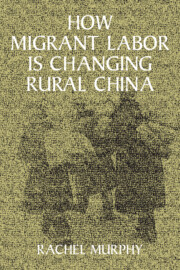Book contents
- Frontmatter
- Contents
- List of Exhibits
- Acknowledgments
- Glossary
- Poem: “I Work in the City”
- Map People's Republic of China
- Map Jiangxi Province
- Introduction
- 1 Values, Goals, and Resources
- 2 China, Jiangxi, and the Fieldwork Counties
- 3 Resource Redistribution and Inequality
- 4 Migration, Remittances, and Goals
- 5 Recruiting Returnees to Build Enterprises and Towns
- 6 The Enterprises and the Entrepreneurs
- 7 Entrepreneurs, Socioeconomic Change, and Interactions with the State
- 8 Returning Home with Heavy Hearts and Empty Pockets
- 9 Conclusion
- Notes
- Bibliography
- Index
2 - China, Jiangxi, and the Fieldwork Counties
Published online by Cambridge University Press: 09 November 2009
- Frontmatter
- Contents
- List of Exhibits
- Acknowledgments
- Glossary
- Poem: “I Work in the City”
- Map People's Republic of China
- Map Jiangxi Province
- Introduction
- 1 Values, Goals, and Resources
- 2 China, Jiangxi, and the Fieldwork Counties
- 3 Resource Redistribution and Inequality
- 4 Migration, Remittances, and Goals
- 5 Recruiting Returnees to Build Enterprises and Towns
- 6 The Enterprises and the Entrepreneurs
- 7 Entrepreneurs, Socioeconomic Change, and Interactions with the State
- 8 Returning Home with Heavy Hearts and Empty Pockets
- 9 Conclusion
- Notes
- Bibliography
- Index
Summary
THIS chapter introduces the reader to socioeconomic change at three levels: China, Jiangxi province, and the fieldwork counties of Wanzai, Xinfeng, and Yudu. Wanzai is situated in Yichun prefecture in northwest Jiangxi, and Xinfeng and Yudu counties are located in Ganzhou prefecture in the south. The chapter explores the changing position of petty commodity producers in Jiangxi within the context of socioeconomic transition in China as a whole. The analysis is concerned with the historical–structural environment in which rural people struggle to obtain resources for attaining their goals; the ways in which these strategies and struggles shape socioeconomic transition at the national, provincial, and county levels; and the responses of the state to those strategies.
The chapter begins by discussing the pre-liberation (pre-1949) history of migration and petty commodity production in the fieldwork counties and in China more broadly. Next I examine the state's repression of petty commodity production under collectivization and the subsequent efforts of the reformist state to channel the economic dynamism and cheap labor of petty commodity producers toward national modernization. The third section discusses economic conditions in Wanzai, Xinfeng, and Yudu; the migration strategies pursued by petty commodity producers in these counties; and the attempts of the local state to manage migration and claim some of the resources that it generates. The fourth section considers the structural features of the political economy that cause the majority of rural migrants in China to retain links with their households.
- Type
- Chapter
- Information
- How Migrant Labor is Changing Rural China , pp. 28 - 51Publisher: Cambridge University PressPrint publication year: 2002
- 1
- Cited by

